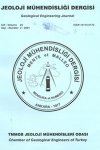
ABSTRACT: Fly and bottom ashes originated from coal burnt in thermal power plants are known to contain several toxicelements, which can leached out and contaminate soils as well as surface and groundwater..Yatağan Thermal Power Plan! ofSx 210 MW power was founded to meet energy need of our country by using low quality lignite reserves of Yatağan- Eskihisar, Tınaz, and Bağyaka basins,. The plant annually consumes5.4 x l(f tons of coal and annual production capacity is 3.780 x 10 KWh, The plant uses 15000 tons of coaland discharges 5000 tons of fly and bottom ash daily to the disposal site.. The main objective of this study isinvestigation of the effects of these wastes on the groundwater, via water in*ash disposal site and groundwatermonitoring wells.. For these reasons, water samples, leach out from waste disposal site and groundwater monitoring wells in front of disposal site., were analysed large part of the Yatağan Plain is formed by alluvium, which is the principal aquifer in front of waste disposal site.. The alluvium consists of loose, interlay e red clay, silt, sand, and gravel, This aquifer is used for domestic and irrigation,. Three observed wells, which are 20 m depth, were clone for effects of waste .disposal site on groundwater. Also,, some of permeability experiments were applied in these welts. According to experimentalluvium aquifer is very permeable.,Groundwater in the alluvial aquifer in the Yatağan Piain, Muğla- Turkey.,, has been effected by thermalpower plant waste. Waters, in the study area, are rich in SO/" ions. Cadmium (Cd) and lead (Pb) concentrations of groundwater of some well in the alluvial aquifer exceed the Environmental Protection Agency (EPA)standarts.
ABSTRACT: Hatay-Erzin plain is located in northeast of iskenderun gulf in the Mediterranean region. The area of plain isabout 300 km2 while its drainage area is 350 km2. Along the Yumurtalık thrust, units of Miocene M is is-And innbasin in north of study area, has a tectonic contact, with the units of Miocene*Iskendemn basin at south..In addition to general hydrogeologic characteristics of the study area, discharge-recharge relation of theBurnaz spring in the discharge area was also studied. Spring has a yield of 1.74 nrVsec. On the basis of regularmonthly discharge data of the spring in the years between 1976 and 1994, minimum, and. maximum, flows areÖ.947 nrVsec and. 4..997 m3/sec, respectively., October and April average discharge values for a 1.9-year period are 1,427 m3/sec and 2..206 mVsec, respectively,. Plain is governed by Mediterranean climate regime. The annualaverage precipitation value recorded at Yeşilkent Observatory for the years 1967-1995 is 930,.5 mm.There are a number of 200 wells (by 1995) in the area drilled, by DSI in order to supply irrigation water forErzin .and. Yeşilkent residential sites. .Discharge measurements show that withdraw from these: wells withincreasing number does not affect the Burnaz spring. Well depths are about 150-200 m in upper parts (between100-200 m) while 50s-150 m in discharge area (between 50-50 m) at west»Conglomerate levels of .upper Pliocene-Pleistocene Erzin formation of the iskenderun basin,, PlioQuaternary-Quaternary porous basalt and sandy and pebbly levels of Quaternary alluvium are. the main aquiferunits in. the study area. On the basis «of pumpage tests, transmissibility values are 105-6110 m2/day inconglomerate aquifer, 2708-14628 m.2/day in basalt aquifer and. 987-5576 m2/day in the whole aquifer. Flowdirection of groundwater is from northeast to southwest and east to west (to the Mediterranean Sea). Hydraulicslope, which is high in the east, decreases to the west due to high permeability of basalt. In Erzin-Yeşilkentplain,, groundwater recharge is 103.3 x 10e m3/y, groundwater discharge is 128.8 x 106 m.3/y and reserveexchange is A.V=-25.5 x 106 nrVy. On the basis of groundwater level changes in the years between 1977 and1996,», regional draw in the recharge area is 4-20 m which fluctuates 1-3 m in the discharge area by the rechargeof Burnaz spring. Recession coefficient (aAve ) for the conglomerate aquifer is 1.52 x 1Ö`3 day"`1 which representsa. tertiary type aquifer.,Burnaz spring issues from two points, through the Plio-Quaternary porous basalt, along the. impermeable partsof alluvium,, thus it can be thought as a contact spring. Discharge elevation of the spring Is about 5-6 m.. On thebasis of spring hydrographs obtained from monthly flow rates measured, in the years between 1976-1994,,, annualaverage discharge, annual recharge of the spring and recession coefficient were calculated as 53.3 x 10`` rn, ,/y,54.4 x 106 m3/y and 4.21 x 10"3 day"1, respectively. In this respect, spring issues through the basalt aquifer whichis greatly fed by annual precipitation,., The correlation coefficient between annual average flow and annual,rainfall Is r=Q.77..In order to examine hydrogeochemical relation between Burnaz spring and other water points in. the plain,samples collected in the area were analyzed for major1 ion and tritium contents. Chemical and tritium resultsindicate that Burnaz spring issues through the basalts in its own recharge area and. that it is a kind of contactspring., On the other hand, tritium contents of other water1 points located in the coastal areas changes, byproportionally of the replenishment from the evaporitic formations.
ABSTRACT: The meaning and definition of terms like resource,, reserve, mine rai, ore etc. Used in earth sciences differfrom engineer to academician and even politician.. This difference results In some sort of confusion andmisunderstanding. In this paper, the definition criteria of some terms like raw material, natural resource, mineral resource, mineral reserve,, mineable reserve and saleable reserve have been defined with examples..The last part of the paper includes Hasançelebi iron ore deposit as a case study

 TMMOB
TMMOB